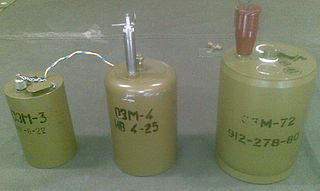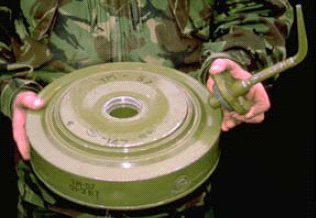Type 72 Non-Metallic is a Chinese circular, plastic bodied landmine which is designed to damage or destroy a vehicle by blast effect.

The Tellermine 35 (T.Mi.35) was a German metal-cased anti-tank mine used extensively during the Second World War. The mine's case is made of sheet steel, and has a slightly convex pressure plate on the top surface with a central fuze well. Two secondary fuze wells are located on the side and bottom of the mine for anti-handling devices.

The MON-50 is a claymore shaped, plastic bodied, directional type of anti-personnel mine designed and manufactured in the Soviet Union. It is designed to wound or kill by explosive fragmentation. The mine is similar to the American M18 Claymore with a few differences.

The MON-90 is a claymore shaped, plastic bodied, directional type of anti-personnel mine designed and manufactured in the Soviet Union. It is designed to wound or kill by fragmentation. The mine is similar in appearance to the MON-50, but is approximately twice the size with a much greater depth.
The PP Mi-D mine is a Czechoslovakian copy of the German Second World War Schu-mine 42 anti-personnel mine.

The OZM-3, OZM-4 and OZM-72 are Soviet manufactured bounding type anti-personnel mines. (fragmentation-barrier mine, in the Russian and other post-Soviet armies as informally called "frog mine" or "witch" )

The TM-57 mine is a large, circular Soviet metal-cased blast anti-tank mine. It can either be triggered by a pressure or a tilt-rod fuze. A development of the TM-46 mine, it is found in Africa, the Middle East, and South East Asia.

The PMN series of blast anti-personnel mines were designed and manufactured in the Soviet Union. They are one of the most widely used and commonly found devices during demining operations. They are sometimes nicknamed "black widow" because of their dark casings.

The M15 mine is a large circular United States anti-tank blast mine, first deployed during the Korean War. Essentially, it is a larger version of the M6A2 anti-tank mine, which it replaced. Although the M15 has been superseded by the M19 mine, the U.S. retains large stocks of M15s because they are still regarded as reliable and effective weapons. When used against main battle tanks the M15 is primarily a "track-breaker" which creates mobility kills, but has a comparatively small likelihood of causing crew fatalities. However, when used against lighter vehicles such as APCs or unarmored vehicles such as trucks the damage inflicted is much more severe.
The AT-8 or Cuban anti-tank mine is a square green plastic cased anti-tank mine. It is a scaled-up version of the Cuban anti-personnel mine. The mine consists of a plastic ribbed hinged upper case which rests on the fuzes placed into the lower plastic case. When enough pressure is placed on the upper lid the strikers are released from the fuzes. This triggers the main charge, which consists of up to twenty 400 g blocks of TNT. The mine is fitted with MUV or RO-1 type fuzes.
The Type 63 AT mine is a large circular Japanese minimum metal anti-tank blast mine. The mine does not float and is waterproof, enabling it to be used in shallow water. The mine uses a standard mechanical pressure fuze, with three ball bearings retaining a spring-loaded striker over a detonator assembly. The Type 63B variant has a secondary fuze well to attach an anti-handling device.
The MKT Mod 72 is an Albanian circular, metal-cased anti-tank blast mine, a copy of the Russian TM-46. Two versions of the mine are produced, the PX designated version of the mine is fitted with a secondary fuze well in the base of the mine that accepts an MUV type anti-lifting device. The mine uses a mechanical pressure fuze similar to the Russian MV-5.
The MBV-78-A2 is a small cylindrical Vietnamese anti-personnel fragmentation stake mine. It is unrelated to the MBV-78-A1. The mine has a large plastic head which contains the main charge wrapped around the detonator. A fragmentation layer of steel pieces set into wax surrounds the main charge. The plastic head has two mounting lugs for stake mounting the mine. A Vietnamese copy of the Russian MUV fuze is typically used with the mine, although other fuzes could be used.
The PPMP-2 is a Yugoslavian anti-personnel stake mine. The mine was not mass-produced, but was built in large quantities at a number of different locations.

The TM-38 was a rectangular, metal-cased Soviet anti-tank mine used during the Second World War. The mine had a large raised rectangular central pressure plate with four reinforcing creases. When enough pressure was applied to the plate it collapses pressing down on a bolt connected to an internal lever. The lever is pulls a retaining pin from the MUV fuze, which releases the striker, which impacts the MD-2 detonator.

The TM-35 was a rectangular, metal-cased Soviet anti-tank mine used during the Second World War. The mine has a metal case, which is rectangular with a carrying handle on one side and a large raised pressure plate in the centre. Sufficient pressure on the central pressure plate presses down on one end of an internal see-saw like lever, which removes the retaining pin from an MUV fuze, releasing the striker, triggering the mine.

The Mark II mine or A./T. Mine G.S. Mk II was a British anti-tank blast mine used during the Second World War. It consisted of a body about seven inches (18 cm) in diameter and two inches high (5 cm). The mine has a central fuze well accessed from the bottom, with a main charge in a cavity around the well consisting of about 4 pounds (1.8 kg) of TNT. The mine is fitted with a thin brass cover, which acts as a pressure plate. The cover is suspended over the main body of the main by four leaf springs. A Sorbo ring made of Sorbo rubber can be fitted between the cover and the mine body, which absorbs shock and blast and allows the mines to be planted as close as two feet (61 cm) without causing sympathetic detonation.
The M432 is a Portuguese bounding anti-personnel mine, which traces the roots of its design to the Second World War German S-mine, although it is probably more directly related to the Belgian NR 442 mine and United States M16 mine. As of 2004, all operational stocks of the mine have been destroyed, although some may have been retained for training purposes.

The Type 9 wooden anti-tank mine was an Italian bar type anti-tank mine used during World War II in North Africa. The box consisted of a lower section, containing the large warhead and fuzes and an upper, overlapping lid with two pivoting wooden covers that sat over the two fuzes. The fuzes were designed as a pivoting lever, and downward motion of the lid caused the lever to pull back a striker, compressing a striker spring until the pivoting action moved the lever enough to release the striker. The striker then impacted a blank cartridge, firing it, triggering a detonator charge, followed by the main charge.
The Mk 4 mine or Mine G.S. Mk IV was a British anti-tank mine used during World War II. Externally the mine has a cylindrical main body filled with explosive either TNT or Baratol. The mine is covered by a pressure plate, which is attached to the mine body by four pins which sit in vertical slots in clips that fold up from the bottom of the mine. The mine uses the Shear-pin based Contact Mine Fuze No.3 Mk I. The fuze consists simply of a spring-loaded striker pin restrained by a shear pin. Sufficient pressure on the pressure plate presses the plate down on the head of the fuze, breaking the shear wire and releasing the striker, which is driven into the detonator by the striker spring.











